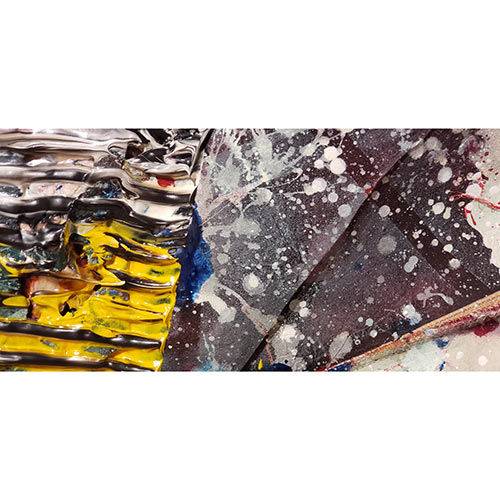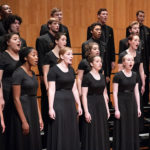
The College of Wooster Art Museum spring exhibition features work from famed abstract artist Sam Gilliam

The College of Wooster Art Museum (CWAM) is displaying its spring exhibition, Essential Matter, Jan. 12 to April 2 in the Sussel Gallery of the Ebert Art Center (1220 Beall Avenue). Curated by CWAM director Marianne Eileen Wardle, Essential Matter centers the piece Looking at the Moon by noted abstract artist Sam Gilliam, placing it in dialogue with works by three regional artists.
Donated to CWAM in 2018, Looking at the Moon was created by Sam Gilliam, a famed artist from Washington, D.C. With a career spanning from the 1960s until just before his death in 2022, Gilliam was an influential artist most well-known for his drape paintings. In these works, Gilliam painted on an unsupported canvas hanging from a ceiling, adding a three-dimensional element to his paintings.
The exhibition also features works from three regional artists: Doug McGlumphy, John Sabraw, and Petra Soesemann. McGlumphy, who is also the preparator and collections manager for the CWAM, is the director of the Olin Fine Arts Gallery at Washington & Jefferson College, where he also teaches sculpture, drawing, and design. Sabraw, professor of art at Ohio University, is an environmentalist as well as an artist, and works to create art that is fully sustainable and reflects environmental issues. Soesemann, who recently retired from her position as a professor at the Cleveland Institute of Art, creates fiber art pieces that are recognized internationally for her use of color and light to represent complex topics.
A unique aspect of this exhibition is that the artists strategically sourced, repurposed, and transformed the materials from which their work was made. The works allude to the original purpose of their materials as their fundamental characteristics carry through into new creations. According to Wardle, “In each case, the meaning of the artwork hinges on this process—none of them could be composed from wholly new materials. Their essential origins and fundamental characteristics are carried through into new creations.”
The artwork in the exhibition was chosen because, “These artworks and their makers focus on deeply human and universal themes, including the ways that we relate to our built, designed, and inhabited environments; stewardship of the ecosystem; our relationships and communities; how we imagine, create, and invent; and the nature of art itself,” said Wardle.
The exhibition will also include an interactive component. Each week, the CWAM will post a question in the gallery and on social media, inspired by statements Gilliam made about his art. These questions allow both the featured artists and community members to reflect on and respond to the artwork and the themes it represents.
The CWAM, located in Ebert Art Center, (1220 Beall Avenue) is open Tuesday through Friday from 11 a.m. to 4 p.m. and Saturday and Sunday from 1 p.m. to 4 p.m. All exhibitions and events are free and open to the public. For additional information, visit CWAM’s website and/or call 330-263-2495.
Featured image: Sam Gilliam, Looking at the Moon (detail), 1991. Mixed media. Collection of the College of Wooster Art Museum. The Raymond Machesney Art Collection, Gift of the Raymond Machesney ’59 Trust. 2018.16. Photograph by Marianne Eileen Wardle.
Posted in Event on January 23, 2023.
Related Posts
Related Areas of Study
Art - Studio Art
Studio space, small classes with talented instructors, and the strong foundation that comes with a liberal arts education.
Major MinorArt - Art History
Explore the cultural and historic significance of art and artists while building research and analytical skills.
Major Minor

